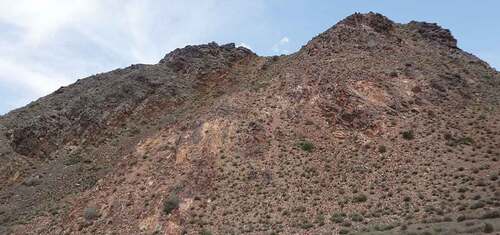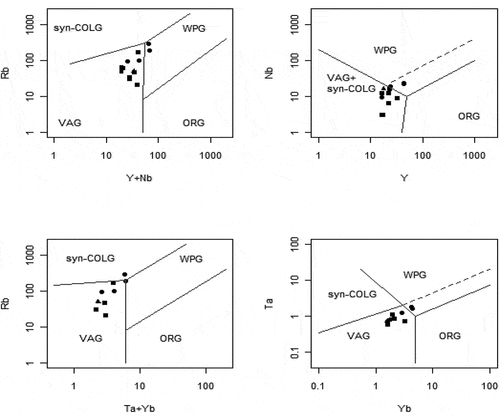ABSTRACT
Eocene to Quaternary calc-alkaline volcanic and intrusive rocks are exposed in Shahrab area in the Urumieh-Dokhtar magmatic belt in the Central Iran structural zone. Data on the geology, petrography, alteration, and geochemistry of rocks are presented. These rocks have compositions ranging from basaltic andesites to dacites and granodiorite. Geochemical studies show that these rocks are calc-alkaline suite and meta-aluminous. Based on field and mineralogical studies, five zones of alteration (propyllitic, carbonatization, Fe oxide, silicified, and argillic) are seen in the volcanic wall rocks. Geochemistry, mineralogy, and petrology properties of Shahrab volcanic rocks attributed to a subduction-related magmatic zone.
KEYWORDS:
1. Introduction
Three major tectonic elements – the Zagros Fold-Thrust Belt, the Sanandaj-Sirjan Zone, and the Urumieh-Dokhtar magmatic arc – are recognized in western and southwestern Iran, which is the result of the opening and closure of the Neo-Tethys Ocean and subsequent collision of the Arabian plate with the Central Iran micro-plate and consists from northeast to southwest of three parallel tectonic subdivisions (Alavi, Citation1994, Citation2004). The Shahrab area is located at 100 km from NE Esfahan in Central Iran (). The igneous rocks in Shahrab belong to Urumieh-Dokhtar magmatic belt (UDMB). The UDMB is a volcanic-plutonic belt that crosses Central Iran in a NW–SE direction that forms a subduction-related, distinctively linear, and voluminous magmatic arc composed of tholeiitic, calc-alkaline, and K-rich alkaline intrusive and extrusive rocks along the active margin of the Iranian plate. The oldest rocks in the Urumieh-Dokhtar magmatic assemblage are Pre-Jurassic calc-alkaline intrusive rocks that are exposed in the southeastern margin of Central Iran.
The youngest rocks in this area consist of lava flows and pyroclastics that belong to Quaternary to Pliocene volcanic cones of alkaline and calc-alkaline composition (Berberian & Berberian, Citation1981). Previous studies indicate that intrusive rocks in the Urumieh-Dokhtar magmatic arc show a large range of rock types, dominated by granite, but with small amounts of granodiorite, quartz diorite, and gabbro, and the plutonic rocks are widely distributed, covering more than 65% of the outcrop area (Rezaei-Kahkhaei et al., Citation2011). The Shahrab violcanic-intrusive rocks contain rhyolite, dacite, tuff, andesite, basalt, granodiorite, and granite. For the purpose of the present study, we use field relationships, petrography, and major and trace element chemistry to determine the geological and geochemical characteristics of the poorly known area in a geologically active zone of Iran.
2. Geological setting
The Shahrab plutonic rocks are a NW–SE trending body covering an area of 800 km2 (). The volcanic sequence is composed of tuffs and volcanoclastic rocks of dacite, rhyodacite, andesite, and basalt. Each volcanic lithology is found at several levels in the stratigraphic column, suggesting multistage extrusion and possibly intrusion. The Shahrab volcanic rocks are considered to be of Eocene in age. The intrusive rocks, including granite, granodiorite, and diorite, cut these Eocene volcanic rocks and is, therefore, intruded in post-Eocene time (). Andesite-basalt, tuff, and dacitic lava are the oldest rocks; they are exposed in the central part of the map area and have the longest contact with the plutonic rocks. The andesitic-basaltic lavas are dark green, green, and brown in colour, with medium-grained phenocrysts, and have minor beds of andesitic tuff. The dacitic, rhyodacitic tuff domes intruded recent lavas, and they belong to the latest volcanic activity in this region in Pliocene. The age of emplacement of these rocks has not been determined by geochronological dating, but based on stratigraphical studies, this volcanic activity began in the late Eocene and continued up to Plio–Quaternary. All these units are overlain by recent alluvium and terraces ().
3. Petrography
3.1. Granodioritic-diorite unit
The granodioritic-diorite unit crops out in the eastern and central parts of the study area, and ranges in composition between diorite and granodiorite. Rocks are generally seriate and medium- to coarse-grained and often show a granular to porphyry texture. The granodiorite composed mainly of quartz, plagioclase, pyroxene, feldspar, and biotite. Ferro-magnesian silicates amount to 5–10% of the modal composition. Apatite, zircon, magnetite, and opaque are common accessory minerals. The diorite rocks have a granular to porphyritic texture and are composed predominantly of plagioclase, amphibole, quartz, epidote, and alkali feldspar ().
Figure 2. Photomicrographs of thin sections of plutonic and volcanic rocks (50X): a) Amphibole phenocryst with plagioclase and quartz in diorite; b) Mafic clots of intergrown plagioclase and amphibole in granodiorite; c) Sphene mineral in granite unit; d) Quartz, feldspar, and plagioclase phenocrysts in fine-grained background; f) leakage background to plagioclase and camaraderie Fe-oxide; (e) crystal vitric tuff including tuff, epidote, and plagioclase in vitreous background with Fe oxide.
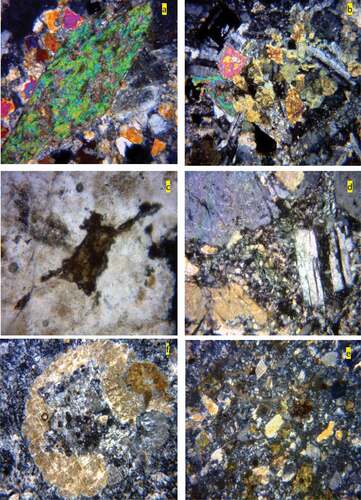
3.2. Granite
The granites are restricted to the center of study area (). They contain plagioclase, K-feldspars, quartz, and biotite with mafic minerals of apatite, sphene, and zircon ()). Magnetite and hematite are the main opaque minerals. Plagioclase (andesine and oligoclase) is usually subhedral and is medium- to coarse-grained. Worm-like or finger-like or droplets of quartz and iron oxides are enclosed in oligoclase. Fine- to medium-grained biotite is the principal mafic mineral in the studied granites. It shows pleochroism from greenish yellow to green color and is often altered to chlorite and opaque minerals.
3.3. Rhyodacite
Quartz (25%), plagioclase (25%), feldspar (25%), and biotite (5%) are the main minerals in the rhyodacite units ()). Accessory minerals include Fe-Ti oxides, carbonate, apatite, zircon, and sphene. The quartz mineral is generally fine- to medium-grained and appears as anhedral to subhedral crystals. The feldspar, represented by small inclusions of magnetite and zircon, sphene, and apatite, occurs as anhedral. Biotite forms individual crystals, fine-grained, deformed, and altered to chlorite.
3.4. Andesite
These rocks have a granular to porphyritic texture with plagioclase megacrysts and are composed predominantly of plagioclase, Fe oxides, epidote, and quartz ()). Plagioclase occurs as euhedral to subhedral prismatic to tabular crystals and medium- to coarse-grained. Biotite forms individual crystals, which are sometimes observed in contact with plagioclase crystals as anhedral.
3.5. Tuff
These rocks have vitreous crystallization as fine granular texture, with quartz, epidote, plagioclase, carbonate, vermiculite, and Fe oxide ()).
4. Alteration
Alteration zones cover an extensive part of the Shahrab area. Based on field and mineralogical studies, five zones of alteration are seen in the volcanic wall rocks: propyllitic, carbonatization, Fe oxide, silicified, and argillic.
4.1. Argillic alteration
The argillic alteration zones are characterized by pale yellow, brown, and white tones. In general, plagioclase is highly altered, and cracks within are filled up by iron oxides and small amounts of carbonate minerals (). Kaolinite is a more abundant mineral. Argillic alteration in Shahrab area occurred by two mechanisms. The main mechanism is the intrusion of granite within the volcanic units. Oxidant water circulation related to weathering and supergene processes, particularly in crush and fault zone, is the next mechanism that acts on rock units and causes deployment argillic alteration in study area.
4.2. Carbonatization alteration
Carbonatization is more intense in basic wall rocks than in felsic rocks, suggesting a lithological control on this process. Calcite, as replacement mineral or filling open-spaces, is the main product of this alteration ().
4.3. Silicic alteration
The silicification alteration is the common type of hydrothermal alteration in study area. Silicification overlies other alteration types, is observed in most of the rocks, and is easily distinguished in the field ().
4.4. Fe oxide alteration
The Fe oxide-alterated rocks are dominated by hematite and often accompanied by argillic alteration ().
4.5. Prophyllic alteration
The prophyllic alteration is the most common type of hydrothermal alteration in the Shahrab area. Prophyllic is the result of low pressure–temperature alteration. The prophyllic assemblage consists of epidote, chlorite, and Fe-Mg-Ca carbonates involved in partial replacement of rock minerals. Chlorte is found to be associated in appreciable quantites with this assemblage, and chloritizatiion is recognized as a separate alteration in some part of study area ().
5. Geochemistry
5.1. Sampling and analytical methods
A total of about 70 rock samples from different localities, including the different unit, were collected. Major (for 25 sample) and trace (for all sample) element measurements were done using X-ray fluorescence (XRF) and inductively coupled plasma-mass spectrometry (ICP-MS), respectively. Detection limits range from 0.01 to 0.1 wt. % for major oxides, 0.1 to 10 ppm for trace elements, and 0.01 to 0.5 ppm for the rare-earth elements.
5.3. Major elements
Representative whole-rock major compositions of some Shahrab area rocks are reported in . SiO2 contents of different samples exhibit wide ranges, approximately from 34.82 to 68.38 wt%, and also other major elements are more variable.
Table 1. Major element contents from the Shahrab igneous rocks.
In the Al2O3/(CaO +Na2O+K2O) versus Al2O3/(Na2O+K2O) [A/CNK vs.A/NK] diagram (Shand, Citation1947)(), the compositions mostly plot into the metaluminous to slightly peraluminous domains, which may be due to fractional crystallization process of subaluminous magma (Zen, Citation1988).
Figure 8. Discrimination of Shahrab rock tectonic setting in Pearce et al. (Citation1984) diagram.
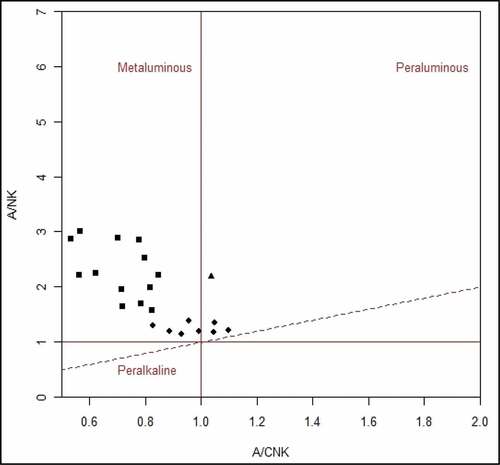
Major element variations are illustrated in major oxide (harker) diagrams (). Harker diagrams show negative correlation between SiO2 vs. TiO2, MgO, CaO, and Fe2O3, and there are smooth increases in Al2O3, K2O, and Na2O.
Figure 9. a) Calcite vein in andesite unit; b) euhedral orthos mineral adjacent carbonatizated phenocryst (50X).
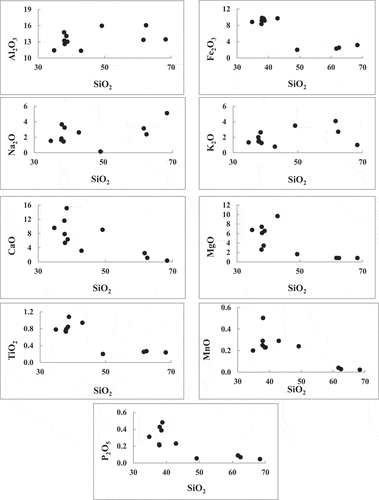
The chemical variations in mafic rocks suggest that a small fractionation of amphibole, magnetite, and apatite has occurred in this unit. Whether plagioclase was fractionated or not is ambiguous by increase in SiO2, and CaO decreases while Al2O3 increases. In general, some samples show scatter trends in major element variation, where probably results from magmatic evolution indicated that fractionation was not a major process in evolution of this suite as a whole.
5.4. Trace elements
Trace element abundances were determined for representative samples of the Shahrab igneous rocks (). Trace element patterns for different Shahrab igneous rock are shown in . All rocks have typical arc signatures with strong but variable large ion lithophile element (LILE) and light rare-earth element (LREE) enrichment and low–high field strength element (HFSE) concentration.
Figure 10. a) Intense silicification in andesite-basalt unite; b) Background silicification as fine-grained quartz in tuff with opaque Fe oxide (50X).
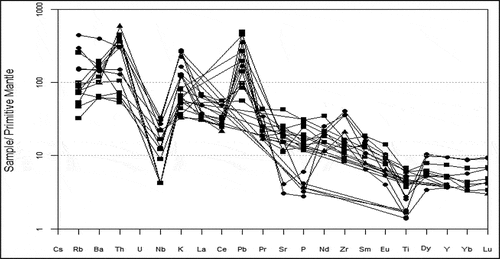
Table 2. Trace element abundances in Shahrab samples.
Some HFSEs (Ti, P) have negative anomalies, whereas others (Ce, Zr, Hf, and Y) have weak positive anomalies. Most of the rocks also have a low content of compatible elements, such as Ni (0.66–36 ppm) and Cr (0.66–121 ppm).
The lower values of Ni, Cr (and Mg#) in mafic, and intermediate rocks may also reflect the absence of primary mantle-derived melts or they may be evolved magma (Feeley. et al., Citation2002). The Ba, Th, and K enrichment in the rocks of study area can be associated with mantle metasomatism processes or continental crustal contamination. Ti and Nb depletion is a characteristic of subduction zone magmatic (Macdonald et al., Citation2000; Pearce et al., Citation1990; Platt & England, Citation1994). Positive anomalies for Pb refer to mantle metasomatism by fluid from the subducted oceanic crust or magma assimilation by continental crust.
6. Tectonic setting
In the Y + Nb vs. Rb, Yb + Ta vs. Rb, Nb–Y, and Yb–Ta diagrams (Pearce et al., Citation1984), all of the igneous samples appear in the volcanic arc granite (VAG) field due to their low values of Nb and Ta (). This conforms to the general tectono-magmatic picture of the region.
7. Conclusions
Based on the major and trace element geochemistry and considering their position in the igneous sequence, rocks can be is divided into two groups: Eocene sequences volcanic rocks and post-Eocene volcanic-intrusive rocks. Trace element normalized patterns of the two groups have a common feature, i.e., Nb and Ti negative anomalies. This is a specific characteristic of subduction zone magmatism. Geochemistry, mineralogy, and petrology properties of Shahrab volcanic rocks can be considered consonant with other findings in Urumieh-Dokhtar magmatic belt (Azizi & Moinevaziri, Citation2009; Ghorbani, Citation2006; Shahabpour, Citation2007) and attributed to a subduction-related magmatic zone. The most important of these features are as follows:
The affinity of the chemical composition of rocks to calc-alkaline series.
Prevalence and trends of trace elements, especially Nb and Ti negative anomalies.
The frequency of andesitic-dacite volcanic rocks
These magmatic rocks form a meta-aluminous and calc-alkaline suite. Alterations have been formed under the influence of hydrothermal fluid that is related to the final activity of intrusive body of area. These intrusive bodies cause the volcanic rocks to be altered. Alteration spreads are often associated with factures, and crushed zone and more are low temperature.
Acknowledgments
We thank an anonymous reviewer for their constructive comments that helped us to better clarify our view and improve the paper significantly.
Disclosure statement
No potential conflict of interest was reported by the author(s).
References
- Alavi,M. (1994). Tectonics of Zagros orogenic belt of Iran, new data and interpretation. Tectonophsics, 229(3–4), 144–149. https://doi.org/10.1016/0040-1951(94)90030-2
- Alavi, M. (2004). Regional stratigraphy of the Zagros fold-thrust belt of Iran and its proforeland evolution. American Journal of Science, 304(1), 1–20. https://doi.org/10.2475/ajs.304.1.1
- Azizi, H., & Moinevaziri, H. (2009). Review of the tectonic setting of Cretaceous to Quaternary volcanism in northwestern Iran. Journal of Geodynamics, 47(4), 167–179. https://doi.org/10.1016/j.jog.2008.12.002
- Berberian, F., & Berberian, M. (1981). Tectono-plutonic episodes in Iran. In H. K. Gupta & F. M. Delany (Eds.), Zagros, Hindu Kush, Himalaya, geodynamic evolution: Geodynamic Series 3, Working Group 6 (pp. 5–32). American Geophysical Union.
- Feeley., T. C., Cosca., M. A., & Lindsay., C. R. (2002). Petrogenesis and Implications of calc-alkaline cryptic hybrid magmas from Washburn Volcano, Absaroka volcanic province. USA Journal of Petrol, 43(4), 663–703. https://doi.org/10.1093/petrology/43.4.663
- Ghorbani, M. R. (2006). Lead enrichment in Neotethyan volcanic rocks from Iran: The implications of a descending slab. Geochemical Journal, 40(6), 557–568. https://doi.org/10.2343/geochemj.40.557
- Macdonald, R., Hawkesworth, C. J., & Heath, E. (2000). The lesser antilles volcanic chain: A study in arc magmatism. Earth-Science Reviews, 49(1–4), 1–76. https://doi.org/10.1016/S0012-8252(99)00069-0
- Pearce, J. A., Bender, J. F., De Long, S. E., Kidd, W. S. F., Low, P. J., Guner, Y., Saroglu, F., Yilmaz, Y., Moorbath, S., & Mitchell, J. G. (1990). Genesis of collision volcanism in Eastern Anatolia, Turkey. Journal of Volcanology and Geothermal Research, 44(1–2), 189–229. https://doi.org/10.1016/0377-0273(90)90018-B
- Pearce, J. A., Harris, N. B., & Tindle, A. G. (1984). Trace elements discrimination diagrams for the tectonic interpretation of granitic rocks. Journal of Petrol, 25(4), 956–983. https://doi.org/10.1093/petrology/25.4.956
- Platt, J. P., & England, P. C. (1994). Convective removal of lithosphere beneath mountain belts: Thermal and mechanical consequences. American Journal of Science, 293, 307–336. https://doi.org/10.2475/ajs.294.3.307.
- Rezaei-Kahkhaei, M., Galindo, C., Pankhurst, R. J., & Esmaeily, D. (2011). Magmatic differentiation in the calc-alkaline Khalkhab–Neshveh pluton, Central Iran. Journal of Asian Earth Sciences, 42(3), 499–514. https://doi.org/10.1016/j.jseaes.2011.04.022
- Shahabpour, J. (2007). Island – Arc affinity of the central Iranian volcanic belt. Journal of Asian Earth Sciences, 30(5–6), 652–665. https://doi.org/10.1016/j.jseaes.2007.02.004
- Shand, S. J. (1947). Eruptive rocks. Thomas Murby and Co.
- Zen, E.A.(1988). Phase Relations of Peraluminous Granitic Rocks and Their Petrogenetic Implications. Annual Review of Earth and Planetary Sciences, 16, 21-51. https://doi.org/10.1146/annurev.ea.16.050188.000321.

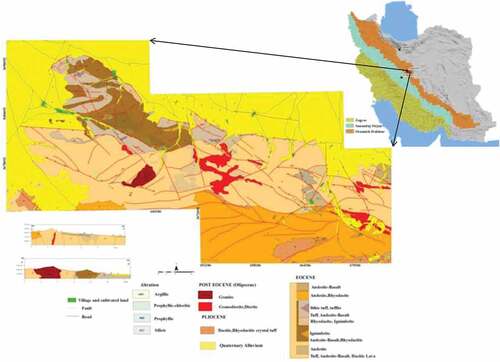
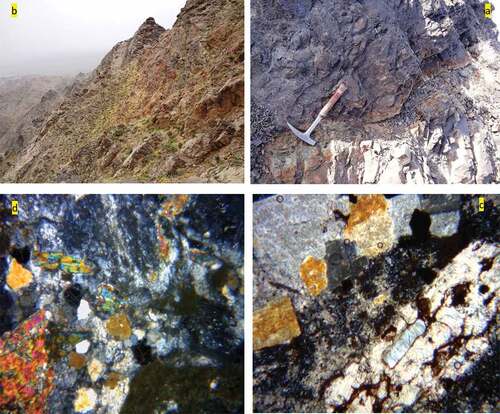

![Figure 5. Molar A/CNK [Al2O3/(CaO + Na2O+K2O)] vs. A/NK [(Al2O3)/(Na2O+K2O)] diagram for the Shahrab rock units.](/cms/asset/16fa8e37-50d2-4db8-b93e-585fba2b6c2e/tgel_a_1952748_f0005_oc.jpg)
